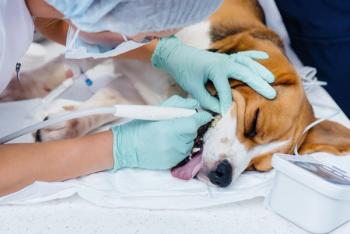
- dvm360 January 2023
- Volume 54
- Issue 1
- Pages: 15
Point-of-care thyroid diagnostic device is shaking up the endocrinology world
TRUFORMA’s novel technology offers reference lab performance in 20 minutes or less
Content sponsored by Zomedica
For Deb Greco, DVM, PhD, DACVIM, endocrinology is like a piecing together a mystery. She is fascinated by the puzzle-solving elements of investigating clues and drawing inferences. At the end of the day, she says, that’s what makes it so satisfying to diagnose Cushing disease or hyper/hypothyroidism. Board certified in veterinary internal medicine, Greco recently retired from her position as a senior research scientist with Nestlé Purina Petcare and is an internationally renowned speaker and expert on endocrine diseases of small animals. She joined
Note: Interview responses have been slightly edited for clarity and readability.
Adam Christman, DVM, MBA, dvm360 Live!™ host:
Talk to me a little bit about the importance of the [thyroxine (T4)] and the free T4 [tests].
Deb Greco, DVM, PhD, DACVIM: In terms of endocrinology, the T4 is total T4. That means it’s all of the thyroid hormone that’s circulating in the bloodstream, where 99% of it is bound to protein so it’s not active. But the free T4 is actually the active form that’s able to diffuse off of the protein into the serum and then across the cell membrane into the nucleus of a cell, where it’s converted to [triiodothyronine (T3)].
Christman: What is the importance of a feline-optimized [thyroid stimulating hormone (TSH) test]?
Greco: The TSH assay was originally developed in the dog species for hypothyroidism. But we found, and this is true with people as well, that the TSH can also be used to diagnose hyperthyroidism. In the dog, when you’re looking at TSH, you want to see if the TSH is elevated, which means the pituitary is trying to drive the thyroid gland to produce more thyroid hormone. In the case of the cat, they develop hyperthyroidism, which means they’re producing too much thyroid and it’s suppressing the TSH. So we had to get the part of the assay that measures the very low end of TSH. We had to optimize that for cats because that’s the value that we’re really interested in, not the high value.
Christman: You use the feline TSH to diagnose early feline hyperthyroidism in cases where T4 is still in the normal range?
Greco: Correct.…They did this as a retrospective study, but they found that the TSH will be suppressed about a year before the free T4 or the total T4 will be elevated. A friend of mine said that the cat is auditioning for hyperthyroidism. When you suspect it and you’re measuring the total T4 and free T4, [and they are in the] high-normal range, but you just can’t make the diagnosis—that’s where the feline optimized TSH is going to be really helpful.
Christman: With hyperthyroidism, there are 2 things that come to my mind…extra blood and adding on tests and time. We have this wonderful machine that’s in front of us, so talk to us a little bit about what that means to our patients for workflow efficiency.
Greco: I’m the world’s most impatient endocrinologist,
so for me this is like the perfect tool. It’s the TRUFORMA machine (Zomedica), and it requires a very small amount of blood. I’ll tell the client we’re going to get a little blood sample, and in about 20 minutes, we’re going to have an answer. I don’t have to send it out to the laboratory [and] it’s probably going to be less expensive for you as well. Then I can provide the medication on their way out.
Christman: My cat just ate; can I still get the blood tests done?
Greco: Absolutely, because the type of methodology that you used here is different than the standard methodology from the lab, which is based on light emission, or radioactivity. This machine works on mass and the change in the weight of molecules, so it’s not going to be influenced by fat in the blood or hemolysis from the red cells being ruptured.
Christman: My colleagues who have the TRUFORMA say that workflow efficiency has been so much smoother, [there has been] greater compliance to doing these things because they want these answers yesterday. We live in a different time now. If it’s something that I need to refer out, maybe I refer my patient over for radioactive iodine 131 treatment, but you get those answers in a timely fashion so…
Greco:…and if it’s a dog, I can prescribe the medication right there and send them out the door.
Christman: It’s a game changer. It really is.
Articles in this issue
almost 3 years ago
Rabbit endotracheal intubation: Yes, you can do it! (Part 2)almost 3 years ago
Retirement planning and the potential 401(k) fallacyalmost 3 years ago
Veterinary-owned management companies: Why not?almost 3 years ago
ABCs of dentistry: Airway, breathing, and circulationalmost 3 years ago
The job descriptionalmost 3 years ago
Build your first veterinary hospitalalmost 3 years ago
The pet obesity epidemic: are we loving our pets to death?almost 3 years ago
Hypoadrenocorticism in the emergency settingalmost 3 years ago
Pet birds need fewer seeds, more formulated dietsalmost 3 years ago
Increasing efficiency and productivity in uncertain timesNewsletter
From exam room tips to practice management insights, get trusted veterinary news delivered straight to your inbox—subscribe to dvm360.




